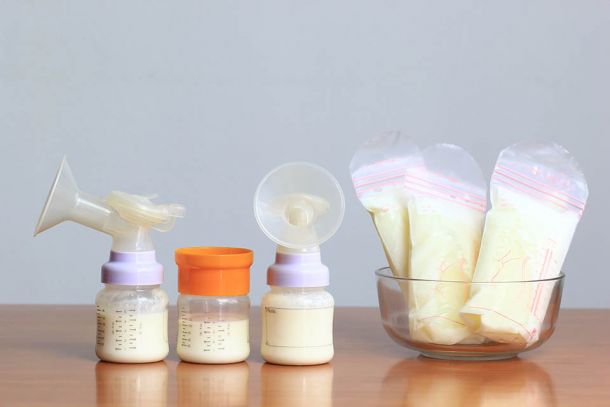
There are many benefits to expressing and storing milk. Expressing a few drops to rub on your nipples will help keep them moist and avoid infections. It will soften your areola, allowing for an easier latch and will give your baby a taste of milk to get him interested in feeding. Expressing and storing milk also allows mom to continue to breastfeed, even when she can’t be with her baby and gives other caregivers a chance to bond over feeding.
Hand Expression
Colostrum is the "first milk" that is produced. Your body creates it during pregnancy and for the first three to four days after birth. This milk is super-charged with important antibodies to strengthen your baby's immune system, it is very easy to digest and helps the baby pass his first stool (meconium). It is important to frequently remove milk from the breast in order to maintain your supply, especially in the first few days after birth as your supply switches from colostrum to mature milk. Ideally, you will breastfeed 8-12 times in those first few days, but if you are still working on establishing a good latch, manual hand expression of colostrum is more effective than using a pump. The following tips will help you express your milk.
- Wash your hands well.
- Use a warm cloth around your breasts or stand in the shower to help start the let-down reflex.
- Massage your breast, moving from the chest towards your nipple, to help the milk come down.
- Hold your breast with one hand – not too close to the nipple – thumb on the upper portion of breast and fingers on bottom, 1 to 1 ½ inches back from the nipple.
- Lift the breast gently and press breast back toward your chest wall.
- Lightly compress your thumb and fingers together in a rolling motion towards the nipple, then relax your fingers.
- Continue this action every few seconds. Don’t squeeze the base of your nipple as it stops the flow of milk.
- Move around your breast so you are emptying the entire breast. You may need to switch hands and continue until milk flow has stopped completely.
- To collect the milk, hold a clean, wide mouth container under your breast with your opposite hand, or place the container on a table in front of you.
Expressing with a Pump
There are many types of breast pumps to choose from: manual, electric, single or double electric pump. Breast pumps can be rented or purchased. It is important to choose a breast pump that lets you adjust the pressure from high to low and has a valve to prevent back flow. The most effective breast pump is a double electric pump, it stimulates milk supply better than single pumps and saves time. If using a manual pump, express on one breast for five minutes, then switch. Continue back and forth for 20 to 30 minutes or until the stream of milk slows.
Breast pumps can hurt if not used properly. Make sure your entire nipple area fits in the funnel of the pump. Start on a low setting and gradually increase the pressure. Be sure to take advantage of the staff at the hospital and Public Health if you have any questions about your breast pump, or if you are experiencing any discomfort or pain while using it.
Manually massaging your breast while pumping can increase supply, you can even breastfeed on one side, while pumping on the other. Breasts should be hand expressed for two minutes after using a pump.
Storing Expressed Breast Milk
Breastmilk is perishable! Use the following guidelines to make sure your expressed breastmilk is safe for your baby.
Keep it clean!
Before expressing milk, wash hands with hot, soapy water for at least 15 seconds. Dry with clean paper towels. Clean wide mouthed containers, or glass jars and lids in hot soapy water as well as any part of your breast pump that will come in contact with your breastmilk. Let dry on clean paper towels.
How long does breastmilk last?
Remember - do not use bottle liners to freeze milk. Always date each container before storing. Use clean, wide mouthed containers to store milk - preferably glass, with lids that have tight seals.
- Room temperature 6-8 hrs. Refrigerate immediately if room temperature is above 25 degrees Celcius.
- Cooler with freezer pack - 24 hrs.
- Fresh milk in fridge – 3 days
- Thawed milk in fridge – 24 hrs.
- Freezer inside fridge – 2 wks.
- Refrigerator freezer - with separate door – 3-6 months
- Deep freezer – 6-12 months
References
http://www.kflapublichealth.ca/Files/Resources/Expressing_and_storing_breastmilk.pdf
